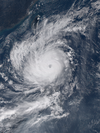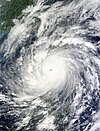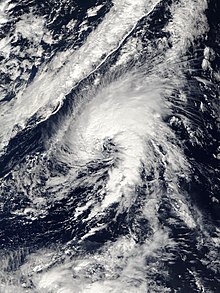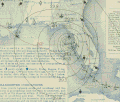Portal:Tropical cyclones
The Tropical Cyclones Portal

A tropical cyclone is a storm system characterized by a large low-pressure center, a closed low-level circulation and a spiral arrangement of numerous thunderstorms that produce strong winds and heavy rainfall. Tropical cyclones feed on the heat released when moist air rises, resulting in condensation of water vapor contained in the moist air. They are fueled by a different heat mechanism than other cyclonic windstorms such as Nor'easters, European windstorms and polar lows, leading to their classification as "warm core" storm systems. Most tropical cyclones originate in the doldrums, approximately ten degrees from the Equator.
The term "tropical" refers to both the geographic origin of these systems, which form almost exclusively in tropical regions of the globe, as well as to their formation in maritime tropical air masses. The term "cyclone" refers to such storms' cyclonic nature, with anticlockwise rotation in the Northern Hemisphere and clockwise rotation in the Southern Hemisphere. Depending on its location and intensity, a tropical cyclone may be referred to by names such as "hurricane", "typhoon", "tropical storm", "cyclonic storm", "tropical depression" or simply "cyclone".
Types of cyclone: 1. A "Typhoon" is a tropical cyclone located in the North-west Pacific Ocean which has the most cyclonic activity and storms occur year-round. 2. A "Hurricane" is also a tropical cyclone located at the North Atlantic Ocean or North-east Pacific Ocean which have an average storm activity and storms typically form between May 15 and November 30. 3. A "Cyclone" is a tropical cyclone that occurs in the South Pacific and Indian Oceans.
Selected named cyclone -
Typhoon Surigae, known in the Philippines as Super Typhoon Bising, was the strongest Northern Hemisphere tropical cyclone to form before the month of May, one of the most intense tropical cyclones on record and the strongest tropical cyclone worldwide in 2021. The second named storm, first typhoon and first super typhoon of the 2021 Pacific typhoon season, Surigae originated from a low-pressure area south of the Micronesian island of Woleai that organized into a tropical depression on April 12. At 18:00 UTC that day, it strengthened to a tropical storm and was named Surigae by the Japan Meteorological Agency (JMA). The formation of an eye and increasing winds prompted the JMA to upgrade the system to a severe tropical storm on April 13. The storm continued to gradually strengthen, and late on April 15, Surigae became a typhoon. Very favorable environmental conditions then allowed Surigae to begin a bout of rapid intensification; Surigae became a super typhoon the next day, and by April 17, the storm reached its peak intensity, with 10-minute sustained winds of 220 km/h (140 mph), 1-minute sustained winds of 315 km/h (196 mph), and a minimum pressure of 895 hPa (26.4 inHg). This made it the strongest pre-May typhoon on record. Afterward, the storm's weakening outflow and an eyewall replacement cycle caused Surigae to gradually weaken as its track shifted north-northwestward in the Philippine Sea. Following the eyewall replacement cycle, Surigae became an annular tropical cyclone on April 19, and restrengthened slightly. On April 22, the storm began to rapidly weaken as it accelerated northwestward into unfavorable environmental conditions, transitioning into a subtropical storm the next day. The subtropical system subsequently underwent extratropical transition, which it completed by April 24. Afterward, Surigae's extratropical remnant accelerated northeastward. On April 27, Surigae's remnant explosively intensified into a bomb cyclone near the Aleutian Islands, attaining hurricane-force winds. Afterward, the system gradually weakened as it turned eastward, slowing down in the process, before crossing the International Date Line on April 30 and fully dissipating on May 2.
Surigae is a North Korean word for the black-eared kite. Upon Surigae's naming, watches and warnings were issued for the island of Yap in the Federated States of Micronesia and the islands of Koror and Kayangel in Palau as well. The typhoon left US$4.8 million in damage in Palau after cutting off power, water, and destroying infrastructure. Later, warnings were raised for parts of the Philippines as the typhoon moved closer to the nation, with evacuations taking place in eastern regions of the Visayas. The storm killed at least 10 people and left another eight missing, in addition to causing at least ₱272.8 million (US$5.67 million) in damage in the Philippines. (Full article...)
Selected article -
The 2005 Azores subtropical storm was the 19th nameable storm and only subtropical storm of the extremely active 2005 Atlantic hurricane season. It was not named by the National Hurricane Center as it was operationally classified as an extratropical low. It developed in the eastern Atlantic Ocean, an unusual region for late-season tropical cyclogenesis. Nonetheless, the system was able to generate a well-defined centre convecting around a warm core on 4 October. The system was short-lived, crossing over the Azores later on 4 October before becoming extratropical again on 5 October. No damages or fatalities were reported during that time. Its remnants were soon absorbed into a cold front. That system went on to become Hurricane Vince, which affected the Iberian Peninsula.
The subtropical nature of this unnamed system was determined several months after the fact, while the National Hurricane Center was performing its annual review of the season. Upon reclassification, the storm was entered into HURDAT, the official hurricane database. (Full article...)
Selected image -

Selected season -

The 2019 North Indian Ocean cyclone season was the second most active North Indian Ocean cyclone season on record in terms of cyclonic storms, the 1992 season was more active according to the Joint Typhoon Warning Center. The season featured 12 depressions, 11 deep depressions, 8 cyclonic storms, 6 severe cyclonic storms, 6 very severe cyclonic storms, 3 extremely severe cyclonic storms, and 1 super cyclonic storm, Kyarr, the first since Cyclone Gonu in 2007. Additionally, it also became the third-costliest season recorded in the North Indian Ocean, only behind the 2020 and 2008 seasons.
The season's first named storm, Pabuk, entered the basin on January 4, becoming the earliest-forming cyclonic storm of the North Indian Ocean on record. The second cyclone of the season, Cyclone Fani, at the time was the strongest tropical cyclone in the Bay of Bengal by 3-minute maximum sustained wind speed until it got tied with Cyclone Mocha of 2023, and minimum barometric pressure since the 1999 Odisha cyclone, while being equal in terms of maximum 3-minute sustained wind speed to 2007's Sidr and 2013's Phailin. Further activity occurred in October, and in the latter part of that month, the first and only super cyclonic storm of the 2010s, Kyarr, formed. (Full article...)
Related portals
Currently active tropical cyclones

Italicized basins are unofficial.
- North Atlantic (2024)
- No active systems
- East and Central Pacific (2024)
- No active systems
- West Pacific (2024)
- No active systems
- North Indian Ocean (2024)
- No active systems
- Mediterranean (2024–25)
- No active systems
- South-West Indian Ocean (2024–25)
- No active systems
- Australian region (2024–25)
- No active systems
- South Pacific (2024–25)
- No active systems
- South Atlantic (2024–25)
- No active systems
Last updated: 10:49, 13 October 2024 (UTC)
Tropical cyclone anniversaries

October 16
- 1942 - A cyclone made landfall near Kolkata, killing 40,000 people.
- 1944 - The 1944 Cuba–Florida hurricane made landfall in western Cuba killing about 300 people.
- 1999 - Tropical Depression Rening which soon became Eve, affects most of Visayas, Philippines as a weak system.
- 2014 - Hurricane Gonzalo (pictured) reached its peak strength, with 1-minute sustained winds of 230 km/h (145 mph). Gonzalo caused damages of $400 million (2014 USD), mostly on the island of Bermuda.

October 17
- 1947 - A US Air Force plane dropped nearly 82 kg of dry ice into the 1947 Cape Sable hurricane off the East Coast of the United States as part of Project Cirrus, the first attempt by man to control a tropical cyclone. The hurricane abruptly changed direction, making landfall near Savannah, Georgia and due to the public blaming the seeding for the change in direction the project was cancelled.
- 2015 - Typhoon Koppu (pictured) made landfall in northern Luzon of Philippines. As a very severe typhoon, Koppu brought flooding where it had killed a total of 58 people and damages up to $235 million.

October 18
- 1970 - Typhoon Kate struck Mindanao in the Philippines, killing 631 people.
- 1985 - Typhoon Dot made landfall on Luzon in the Philippines. Dot killed 90 people and caused more than $80 million in damage.
- 2010 - Typhoon Megi (pictured) struck Luzon in the Philippines at peak intensity, and it later affected Taiwan with heavy rainfall, causing 69 deaths.
Did you know…




- …that the Joint Typhoon Warning Center considers that Typhoon Vera (pictured) of 1986 is actually two distinct systems, formed from two separated low-level circulations?
- …that Cyclone Freddy (track pictured) in 2023 was the longest-lasting tropical cyclone worldwide?
- …that Cyclone Raquel (track pictured) travelled between the Australian and South Pacific basins between the 2014–15 and 2015–16 seasons, spanning both seasons in both basins?
- …that Hurricane Otis (pictured) in 2023 was the first Pacific hurricane to make landfall at Category 5 intensity and surpassed Hurricane Patricia as the strongest landfalling Pacific hurricane on record?
General images -

Category 4, the second-highest classification on the Saffir–Simpson scale, is used for tropical cyclones that have winds of 130–156 mph (209–251 km/h; 113–136 kn). The division of the eastern and central Pacific basins occurs at 140° W; the eastern Pacific covers area east of 140° W, while the central Pacific extends between 140° W to 180° W. Both basins' division points are at 66° N as a northern point and the equator as the southern point. As of 2024[update], 143 hurricanes have attained Category 4 status in the northeastern Pacific basins. This list does not include storms that also attained Category 5 status on the scale.
Numerous climatological factors influence the formation of hurricanes in the Pacific basins. The North Pacific High and Aleutian Low, usually present between January and April, cause strong wind shear and unfavorable conditions for the development of hurricanes. During its presence, El Niño results in increased numbers of powerful hurricanes through weaker wind shear, while La Niña reduces the number of such hurricanes through the opposite. Global warming may also influence the formation of tropical cyclones in the Pacific basin. During a thirty-year period with two sub-periods, the first between 1975 and 1989 and the second between 1990 and 2004, an increase of thirteen Category 4 or 5 storms was observed from the first sub-period.
(Full article...)Topics
Subcategories
Related WikiProjects
WikiProject Tropical cyclones is the central point of coordination for Wikipedia's coverage of tropical cyclones. Feel free to help!
WikiProject Weather is the main center point of coordination for Wikipedia's coverage of meteorology in general, and the parent project of WikiProject Tropical cyclones. Three other branches of WikiProject Weather in particular share significant overlaps with WikiProject Tropical cyclones:
- The Non-tropical storms task force coordinates most of Wikipedia's coverage on extratropical cyclones, which tropical cyclones often transition into near the end of their lifespan.
- The Floods task force takes on the scope of flooding events all over the world, with rainfall from tropical cyclones a significant factor in many of them.
- WikiProject Severe weather documents the effects of extreme weather such as tornadoes, which landfalling tropical cyclones can produce.
Things you can do
 |
Here are some tasks awaiting attention:
|
Wikimedia
The following Wikimedia Foundation sister projects provide more on this subject:
-
Commons
Free media repository -
Wikibooks
Free textbooks and manuals -
Wikidata
Free knowledge base -
Wikinews
Free-content news -
Wikiquote
Collection of quotations -
Wikisource
Free-content library -
Wikiversity
Free learning tools -
Wikivoyage
Free travel guide -
Wiktionary
Dictionary and thesaurus

























































